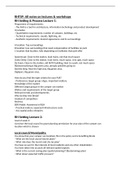Samenvatting
Summary Recreation & Hospitality Settings & Process (CITM2.RHTSP-01)
This document includes all notes on the lectures, guest lectures and workshops including an example on the pre-phase and planning phase. This was for the course RHTSP at the BUAS/NHTV.
[Meer zien]




